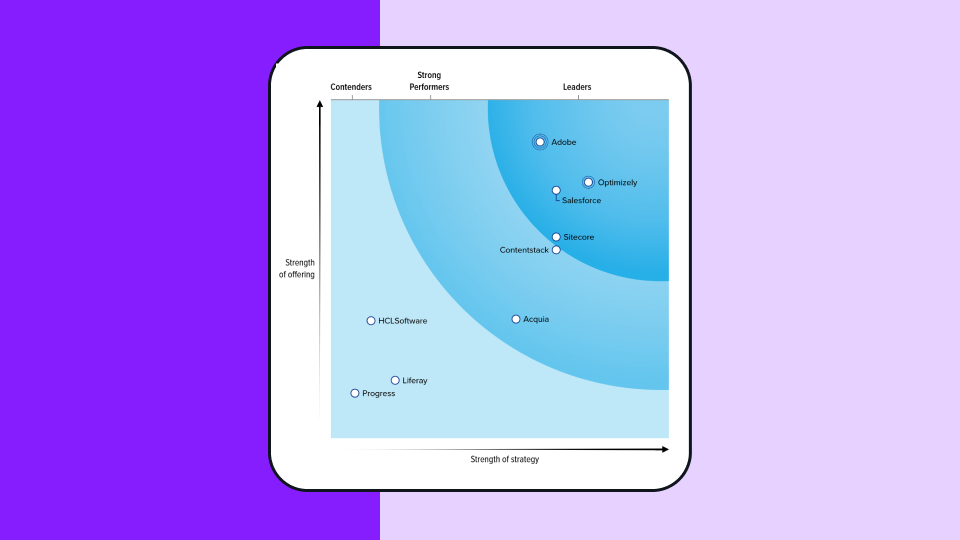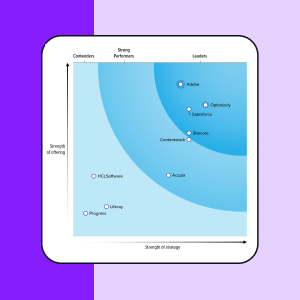Abbildung der Customer Journey
Was ist die Abbildung der Customer Journey?
Mit der Abbildung der Customer Journey können Sie visualisieren, wie und wo Kunden auf Ihrer Website oder in Ihrer Mobile App mit Ihrer Marke interagieren. Es hilft Ihnen bei der Optimierung jedes Kundenerlebnisses, indem es alle Berührungspunkte zu einer zusammenhängenden Geschichte verknüpft.
Um Erkenntnisse zu gewinnen, erforschen Sie die Erlebnisse Ihrer Kunden, um detaillierte Personas zu erstellen und jeden Berührungspunkt auf der Customer Journey abzubilden.
Eine individuelle Abbildung der Customer Journey umfasst alle Schritte (oder Benutzerströme), die ein Kunde bei der Interaktion mit Ihrem Unternehmen durchlaufen muss, um ein bestimmtes Ergebnis zu erzielen. Die Abbildung der Customer Journey ist ein Prozess zur Identifizierung aller Kundenprozesse und zum Verständnis der Kundenwahrnehmung während dieser Interaktionen.
Die Abbildung der Customer Journey wird auch als Ersatz für Buyer Journey oder User Journey verwendet. Mit Hilfe der Abbildung der Customer Journey können Unternehmen alle Berührungspunkte, die ein Kunde bei der Interaktion mit Ihrem Unternehmen durchläuft, nachvollziehen. Ziel der Abbildung der Customer Journey ist es, alle Reibungspunkte, die ein Kunde beim Durchlaufen der verschiedenen Berührungspunkte erleben kann, zu identifizieren und zu beseitigen.
Vorteile der Abbildung der Customer Journey
- Mehr Kundenzufriedenheit bedeutet mehr Umsatz durch Weiterempfehlungen.
- Mehr Möglichkeiten zum Upselling durch ein verbessertes Erlebnis für den Kunden.
- Mehr Umsatz für jeden Marketingdollar, den Sie ausgeben.
- Zufriedenere Kunden mit einem höheren Customer Engagement.
- Mehr Kunden entscheiden sich dafür, ein Produkt oder eine Dienstleistung weiter zu nutzen.
- Besseres Verständnis der Unternehmensziele nach Durchsicht des Kundenfeedbacks
Um die Ziele des Unternehmens zu erreichen, müssen Sie alle wichtigen Berührungspunkte identifizieren, bevor Sie mit der Optimierung des Erlebnisses beginnen und alle Reibungspunkte beseitigen können.
Eine detaillierte Customer Journey-Karte ist der erste Schritt zur Beseitigung von Erfolgshindernissen und zum Aufbau optimierter Erlebnisse über alle Kanäle hinweg.
Wozu braucht man ein Customer Experience Mapping?
Unternehmen konkurrieren zunehmend über das Erlebnis und nicht über den Preis. Die Abbildung der Customer Journey identifiziert umsetzbare Berührungspunkte, die dabei helfen, Strategien zu formulieren, die aktuell, personalisiert, ergänzend und relevant für die Persona eines bestimmten Kunden sind.
- Sie können ein tieferes Verständnis für die Bedürfnisse Ihrer Kunden gewinnen und dafür, was genau sie von Ihrer Website erwarten.
- Sie können die Berührungspunkte mit Ihrer Marke identifizieren und diese verbessern, um die Wirkung jeder Interaktion mit Ihrem Kunden zu maximieren.
- Sie können die Erlebnisse Ihrer Kunden auf Ihrer Website verbessern, indem Sie personalisierte Berührungspunkte schaffen, die spezifische Schmerzpunkte lösen.
- Sie können negative Erlebnisse minimieren, um den Umsatz zu steigern und die Kundenbindung zu verbessern.
- Sie können bei Omnichannel-Touchpoints Lücken zwischen verschiedenen Journeys und Erlebnissen identifizieren und beseitigen.
Kunden erwarten heute über alle digitalen Kanäle und Berührungspunkte hinweg den gleichen Komfort während der gesamten Customer Journey. Das Wachstum eines Unternehmens hängt davon ab, dass es sein digitales Potenzial ausschöpft, indem es Kunden anspricht und Reibungspunkte im Prozess beseitigt.
Die Abbildung der Customer Journey ist der beste Weg, um den gesamten Technik-Stack (oder Martech) eines Unternehmens über alle Berührungspunkte mit dem Kunden hinweg abzustimmen und konsistente, zusammenhängende Erlebnisse für alle digitalen Kanäle zu schaffen.
Beispiele für die Abbildung der Customer Journey
- Besucher über Anzeigen und die organische Suche auf Ihre Site bringen.
- Interaktion auf sozialen Medienkanälen und Weiterleitung der Besucher auf bestimmte Landing Pages.
- Bieten Sie eine Kontoregistrierung auf Ihrer Site an, um Vorteile und Rabatte zu erhalten.
- Personalisieren Sie Produktseiten und zeigen Sie Käufern genau das, wonach sie suchen.
Vorlage für eine Customer Journey-Karte
Um eine Customer Journey-Map zu erstellen, müssen Sie sich zunächst in die Lage Ihres Kunden versetzen und alle Targeting-Aktionen identifizieren, die der Kunde am Ende einer bestimmten Reise erreichen soll. Diese Aktionen richten sich nach den Bedürfnissen der Kunden und umfassen in der Regel Ereignisse wie:
- Einen Kauf tätigen
- Bestellung einer Dienstleistung
- Einreichen einer Anfrage für weitere Informationen oder Support
Jede Phase, die ein Benutzer durchläuft, um das gewünschte Ergebnis zu erreichen, sollte Teil Ihrer Abbildung der Customer Journey sein.
Hier sind die 8 Phasen:
-
Bekanntheit
Potenzielle Kunden haben Hindernisse und suchen nach Lösungen.
Aktionen - Marketingkampagnen, Marktforschung, Werbung, Präsenz in den sozialen Medien, Content Marketing.
Berührungspunkte - Anzeigen, Beiträge in sozialen Medien, Blogartikel, Infografiken, Mundpropaganda, PR. -
Erwägung
Kunden vergleichen verschiedene Lösungen oder Marken, indem sie Informationen einholen.
Aktionen - Produktinformationen, Vergleichsseiten, Fallstudien und Testimonials.
Touchpoints - Unternehmenswebsite, Bewertungen, Online-Foren, Vergleichswebsites, Webinare. -
Entscheidung
Kunden sprechen mit dem Vertriebsteam oder entscheiden sich direkt für eine Marke und fahren mit dem Kauf fort.
Aktionen - Kostenlose Testversionen, Rabatte, einfache Kaufprozesse und Kundensupport.
Touchpoints - Online-Shop, Vertriebsmitarbeiter, Checkout-Prozess, Kommunikation per E-Mail. -
Kauf
Kunden schließen die Kauftransaktion ab.
Aktionen - Reibungslose Transaktionsabläufe, mehrere Zahlungsoptionen, Nachrichten zur Bestellbestätigung.
Berührungspunkte - Zahlungsgateway, Bestätigungs-E-Mails, Lieferoptionen, Kundendienst. -
Einarbeitung
Kunden beginnen mit der Nutzung des Produkts, um den größten Nutzen daraus zu ziehen.
Aktionen - Tutorials, Benutzerhandbücher, Einführungs-E-Mails, Hilfe bei der Einrichtung.
Berührungspunkte - Willkommens-E-Mails, Benutzerhandbücher, Kundensupport, Einführungsanrufe. -
Nutzung
Kunden nutzen das Produkt oder den Service regelmäßig und geben anschließend Feedback.
Aktionen - Sammeln Sie Feedback und bieten Sie kontinuierlichen Support.
Berührungspunkte - Produktoberfläche, Kundendienst, FAQs, Support-Tickets. -
Bindung
Kunden bewerten und entscheiden, ob sie das Produkt oder die Dienstleistung weiterhin nutzen möchten.
Aktionen - Einbindung von Kunden, Treueprogramme, Einholung von Feedback und Behandlung von Problemen.
Touchpoints - Treueprogramme, Kundenbefragungen, Feedback-Umfragen, Kundenerfolgsteams, Verlängerungsbenachrichtigungen. -
Befürwortung
Wenn ein Kunde zufrieden ist, empfiehlt er das Produkt oder die Dienstleistung wahrscheinlich weiter.
Aktionen - Bewertungsseiten, Empfehlungsprogramme und Möglichkeiten zum Engagement in der Gemeinschaft.
Berührungspunkte - Soziale Medien, Sites für Bewertungen, Empfehlungslinks, Community-Foren.
Indem Sie jede Interaktion und das Gesamterlebnis des Kunden bei der Interaktion mit Ihrem Unternehmen ermitteln, können Sie Ihre Customer Journey verbessern, um den Umsatz zu steigern, die Click-Through-Rate zu erhöhen oder jede andere Kennzahl zu optimieren, die das Wachstum fördert.
Wie erstellt man eine Abbildung der Customer Journey?
Die Abbildung der Customer Journey beginnt mit klaren Zielen, die das Format, die Komplexität und die ergänzenden Inhalte bestimmen, die für eine nahtlose Reise durch die verschiedenen Berührungspunkte erforderlich sind. Ziel ist es, mithilfe von Forschung und Experimentieren weitere Reibungspunkte zu identifizieren und zu beseitigen.
-
Identifizieren Sie Personas von Kunden
Personas sind die Kategorien, mit denen Sie Ihre Kunden je nach den angestrebten Aktionen segmentieren. Um die Customer Journey zu optimieren, müssen Sie die Motivationen, die wichtigsten Aufgaben und die möglichen Schmerzpunkte jeder Persona über alle Kanäle hinweg kennen. -
Zeichnen Sie die verschiedenen Phasen auf
Jede Reise kann mehrere entscheidende Berührungspunkte während der verschiedenen Phasen des Erlebnisses haben. Planen Sie die Reise für jede Phase entsprechend der Zielhandlung, die Sie erreichen möchten. Die verschiedenen Phasen können Situationen wie Entdeckung, Erkundung, Vergleich, Bewertung, Kauf, Bindung und Empfehlung oder Testimonial umfassen. -
Listen Sie die Kontaktpunkte für jede Phase auf
Nehmen Sie alle Berührungspunkte, die Kunden derzeit zur Verfügung stehen, entsprechend der Phase in Ihre Journey Map auf. Sobald Sie alle Berührungspunkte kennen, können Sie die Journeys nach Phasen und zugehörigen Targeting-Aktionen überprüfen, um optimierte Erlebnisse zu finden, die Umsatz und Wachstum fördern. -
Forschen und Experimentieren Sie
Für alle digitalen Berührungspunkte sollten Sie kontinuierlich experimentieren, um Ihre aktuelle Leistung mit Hilfe von Analytik, Verhaltenswissenschaft und multivariaten Tests zu bewerten. Es gibt verschiedene Entwicklungs- und Implementierungsstrategien, die Teams bei der Identifizierung und Gestaltung optimaler Erlebnisse für verschiedene Personas und die dazugehörigen Journeys unterstützen. -
Implementieren Sie neue Customer Journeys auf der Grundlage von optimierten Karten
Auf der Grundlage Ihrer Untersuchungen können Sie nun optimierte Customer Journeys für das bezahlte und organische Web, soziale Medien und andere digitale Kanäle implementieren. Qualitative und quantitative Forschung wird den gesamten Prozess unterstützen, während Plattformen für digitale Erlebnisse (Digital Experience Platforms, DXP) Sie beim Experimentieren, bei der Koordination, beim digitalen Content Management und bei der Implementierung unterstützen.
Erfolgsmethoden für die Abbildung der Customer Journey
Zu Beginn des Prozesses müssen Sie klare Ziele festlegen, die verschiedene Bewertungskriterien für Variablen wie Buyer Personas und angestrebte Ergebnisse kontextualisieren. Nutzen Sie diese Informationen, um klare Ziele zu definieren und die entscheidenden Berührungspunkte in der aktuellen Customer Journey zu identifizieren.
Setzen Sie Prioritäten bei der Optimierung der entscheidenden Berührungspunkte, aber legen Sie auch eine Vision für die gesamte Reise fest und identifizieren Sie alle anderen Interaktionen, die das Potenzial haben, den Umsatz zu steigern. Mit Ihren aktuellen Plänen beginnen Sie mit dem Testen der Customer Journey, um die wichtigsten Reibungspunkte zu finden, die gelöst werden müssen.
Weitere Erfolgsmethoden für die Abbildung der Customer Journey, die Sie berücksichtigen sollten
- Zuweisung der richtigen Ressourcen - Sie müssen die richtigen Teams einbeziehen und eine Bestandsaufnahme aller (menschlichen und digitalen) Ressourcen erstellen, die an der Customer Journey beteiligt sind.
- Erfassen Sie die Berührungspunkte -- Die Entwürfe müssen über alle Kanäle hinweg konsistent sein und die erforderliche Integration dort einbeziehen, wo sie das Kundenerlebnis (CX) beeinflussen könnte.
- Optimieren Sie das Design der Customer Journey vor dem Rollout -- Durch Experimentieren können Sie verschiedene Versionen von Designs, Layouts und Inhalten testen, bevor Sie sie bei allen Kunden einsetzen.
Optimizely und Customer Journey-Mapping
Bei der Erstellung von Customer Journey-Maps geht es in erster Linie darum, die Gedanken der Kunden zu verstehen und zu quantifizieren, wie sie Ihr Unternehmen während der verschiedenen Interaktionen erleben.
Mit Optimizely können Unternehmen mit Hilfe von Erlebnisanalytik, Experimentieren und der Abbildung der Customer Journey überlegene Erlebnisse und eine Mischung von Inhalten für verschiedene Personas liefern.
Beginnen Sie mit der Personalisierung in Echtzeit, die Ihre Kunden lieben werden.

